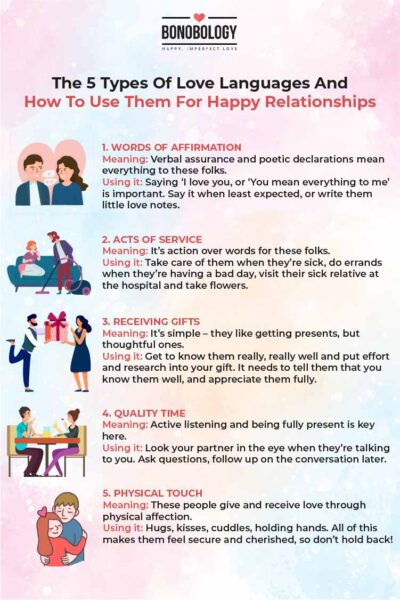Dr. Chapman came up with the framework that each of us has our own way of expressing love, known as love languages, and our own way of wanting to receive it. To navigate and understand the different types of love languages was, therefore, the key to a healthy and sustainable relationship. There are, Dr. Chapman, claimed, five primary types of love languages and each had its unique components. So, what are the 5 types of love languages? In this article, we take a deep dive into 5 love languages in relationships with the expertise of Psychotherapist Jui Pimple (MA in Psychology), a trained Rational Emotive Behavior therapist and A Bach Remedy practitioner who specializes in online counseling.
What Are The 5 Types Of Love Languages?
Each one of us has a love language type to which we are most receptive. However, we are unaware of the distinction between the different love languages. For instance, you might feel loved when your partner gives you a gift. That is a love language for you. In a healthy and long-term relationship, understanding your partner’s form of love language is the key to maintaining harmony. And that’s what this article intends to do. So, without further ado, here are 5 love languages in a relationship:
1. Words of affirmation
Jui explains, “Verbal expressions of love and affection are key to people for whom words of affirmation are the primary form of love language. They will frequently use statements such as ‘I love you’ or ‘I am glad to have you in life’. People with this love language also like to hear such words from their partner; it’s how they feel loved and reassured, and thereby safe to express their own feelings.” Expect a lot of text messages, or even little love notes and emails. These are people who are fulsome with compliments and will always be the first to leave comments on their partner’s social media posts.
2. Quality time
If your partner loves just hanging out with you on the couch or having you around when you’re not doing much, their dominant love language type is quality time. “Having quality time is an important part of most relationships,” says Jui, “But people with this love language express their feelings to their partner by simply being with them, spending time together even when they are not doing anything specific. There are always different ways to spend quality time to make your partner feel loved and also make your relationship richer.” Mind you, quality time would mean undivided attention and being fully present with each other. When they’re telling you about their day, they want you to really listen better, and not just zone out and nod.
3. Acts of service
We’ve all heard that actions speak louder than words, and now it’s an entire love language all by itself. Love is a verb, after all. So, if they’re always ready to wash up after a meal, or bring you your morning coffee, their love language is all about acts of service. Jui says, “Some people may value actions more than words – they would go out of the way to help their partner as a way of showing how much they love them. For such people, a partner should also try to be a helpmate in their everyday activities and make small gestures that make them feel loved and cherished.” It’s possible these are people who aren’t all that verbal or physical with their expressions of affection, but they’ll be standing right next to you, ready to help whenever you need them.
4. Gifts are a form of love language
Who doesn’t love getting presents, right? However, for some people, receiving and giving gifts is a type of love language. Gift-giving is such a great way to show that you care about someone, that you were thinking about them, and so on. Material manifestations of love might not be everything, but it’s always great to receive love tokens. Who doesn’t want to get cozy gifts for a girlfriend or boyfriend and watch their faces light up? “Surprising your partner with a thoughtful present can delight them. People with this love language often give gifts to their partners and in return, they thoroughly appreciate receiving gifts from them too. Giving and receiving gifts is one major way of loving their partner,” says Jui.
5. Physical touch
Touch is an important component of any healthy relationship, and physicality is truly its own form of love language. If your partner’s idea of a great evening is snuggling with you on the couch, if they’re the sort who always holds your hand, physical touch is their primary way of telling you how they feel. It doesn’t always have to lead to sexy time, either. Non-sexual touch is just as significant to these folks. “Physical touch is not necessarily a sensual one,” Jui says. “This could also be holding hands in public, caressing your hair, or resting their head on your shoulder while you travel in a car or bus. These people feel loved with small physical acts such as kissing and hugging frequently throughout the day.”
What We Need To Know About Different Types Of Love Languages
Now that we know what are the 5 types of love languages, how do we navigate them? The world of language and love is rich and complex. To truly know and understand our own and our partner’s love languages before we apply them to our relationships, we have to delve deep within. We rounded up a prep course of sorts to help you navigate the different types of love languages.
1. Know your own love language
How do you behave with people you love? What’s your instinctive reaction toward them? Do you immediately want to send them a long text message? Or touch their shoulder lightly? Do you always see the ‘perfect’ gift for them when shopping online? Just as it’s important to know yourself before you enter an intimate relationship, it’s also vital to acknowledge and understand your own love language categories before you try and understand your partner’s. So, pay attention to yourself, so that you can be clear about your needs and expectations with your form of love language.
2. Pay attention to your partner’s love language
Now that you’ve hopefully mastered your love language types, or at least figured out what it is, it’s time to turn your attention to your partner. Figuring out a love language takes both time and effort. Just because they made you tea one day doesn’t really mean their love language is an act of service. Pay attention to what they do frequently when they want to show how much they care about you. After all, there are lots of tiny, subtle ways to show someone you care. This is also a good way to recognize their efforts, especially when their love language isn’t the same as yours. “It’s important to acknowledge both your love languages. If they tend to differ, try to understand your partner’s love language and at the same time, communicate yours to them. Discover various ways of communicating and expressing based on both your love languages,” Jui advises.
3. Understand that your dominant love language could change
It’s easy to assume that once you’ve identified both your own and your partner’s love language types, they’re going to remain the same forever, and you’ve got it all figured out. But people change and our expressions of love change along with us. It would be normal, for instance, for physical touch to be your primary love language at the start of a relationship, and for it to become act of service as you grow older. Also, people are perfectly capable of having two primary love languages – one to give love and another to receive it. This isn’t a sign that your love is fading or your relationship is on the verge of a breakup. It’s just that love is dynamic and our expressions change with age and circumstances.
4. Remember, love languages are a tool, not a cure
Ultimately, these love languages are a way to communicate more effectively, to make a relationship stronger and richer with better understanding. They are not, however, a miracle cure for an ailing relationship. You could do everything to learn your partner’s love language and still not be able to get through to them or understand them fully. And if a relationship already has problems, simply knowing each other’s love language won’t be enough to make it go away. In this case, you could seek professional help from Bonobology’s panel of counselors to help mitigate your problems.
How To Use The 5 Love Languages To Make Your Relationship Stronger
So, we’ve gone through the different types of love languages, their definitions, and how to know them a little better. But, how do you apply all this knowledge to your own relationship? What practical and loving acts can we commit in order to use these love languages to make our relationship stronger? We came up with dos and don’ts to speak each of the love languages a little better, with greater authenticity and empathy, to make your relationship stronger.
1. When their love language is words of affirmation
“I really like it when my partner appreciates me verbally,” says Mandy. “It’s important to me that he notices when I’ve had a new haircut, or if I’m wearing a new dress, or even if I made something different for dinner. When he tells me, I’m looking pretty, or that he’s proud of me for a task I accomplished, I feel loved and secure and cherished. I feel seen.” Dos: Step up your word skills. Tell your partner ‘I love you a lot and say it out of the blue. Send them an email in the middle of a workday just to say you’re thinking about them. In times of relationship conflict, apologize in so many words. Don’ts: Do not assume they know how you feel because ‘what are words anyway?’ Don’t use unkind words when you’re fighting. And do not give them the silent treatment to express your anger or disappointment.
2. When their love language is quality time
Time is precious in any relationship and we’re constantly feeling the lack of it in our busy, often overwrought lives. Making time for our partners and our relationship isn’t easy, but if your partner’s form of love language is quality time, it doesn’t hurt to make an extra effort. After all, you’ll get to spend time with them too, so it’s a win-win. “We do date nights at least once a week just to ensure we have that space to catch up,” says Andrew. “I would often just come home, slump on the couch and make mechanical responses to my wife’s questions. Till I realized she was genuinely trying to have a little time with me, and it was important to her.” Dos: Make eye contact when they’re talking to you. Listen, really listen and follow up later on if possible. Ensure your conversation isn’t interrupted by kids or phone calls or the TV.
3. When their love language is acts of services
One of my partner’s primary love languages is definitely acts of service, and I’m sorry to tell you I often overlook it. He’s always doing things like picking up medicines and ice cream when I’m dying of cramps, doing the dishes when my domestic help is absent, and is just generally prepared to do any chore or drive anyone wherever they need to go. He’s given strangers a lift in his car because they ‘seemed lost’.
Because of this, he’s also someone who will take on more work than he can easily handle and then exhaust himself doing it all. Personally, I find this love language deeply touching but also easy to dismiss because it doesn’t always come with big romantic gestures.
Dos: Reciprocate their acts by doing small chores and being a helpmate when they need. Appreciate their small gestures. Prioritize what you’re doing for them at least some of the time.
Don’ts: Don’t ignore their requests for help, because they rarely ask. Don’t say you’ll help or do something and then just not do it.
4. When their love language is receiving gifts
It’s hard to see how this love language could be misunderstood or go wrong, but like all expressions of love, it is open to interpretation.
A really good gift speaks volumes about your powers of observation and how well you know your partner. We’re not talking about buying her a necklace after she left 20 hints around the house. When you’re responding to or nurturing the love language of receiving gifts, you have to truly know what they want.
“My partner once gifted me a first edition copy of my favorite childhood book,” says Toni. “I’d told her about it a long time ago, and she remembered. I think the fact that she’d heard me, that she remembered, was as sweet as the gift itself.”
Dos: Put thought into the gift. Make sure it’s a symbol of how well you know them and how much you value your relationship.
Don’ts: Do not wait for a special occasion. Gift-giving is open all year round. Don’t assume that an expensive gift will trump a thoughtful one.
5. When their love language is physical touch
I’m a deeply physical person, a serial hugger and a cuddle fan. If I’m trying to comfort someone, I put a hand on their shoulder. When I’m feeling tender, I cup my partner’s face in my palm. I greet everyone I know with a hug if they’re okay with it.
As we’ve pointed out, physical touch does not equal sensual touch, or even necessarily preclude a sexual encounter. Those of us who own this as our primary love language just like the feel of skin on skin.
You’ll always find me working with my feet on my partner’s lap. We love holding hands with the fingers linked all the way through. Physical touch is how we connect and how we communicate. It’s also sometimes the most easily misunderstood love language, so consent and body language signs are important.
Dos: Lots of non-verbal affirmation and affection is essential. Warm, gentle physical touch – hugs, forehead kisses, holding hands.
Don’ts: Physical coldness without explanation can be hurtful. Long periods without physical intimacy don’t work. Don’t neglect usual physical overtures such as a good morning kiss.
We’ve talked about all the five types of love languages, and how they can be used to make our relationships better. Remember, there are all types of love, and we all carry seeds of more than one love language. There’s no knowing which one could be dominant. Human nature is not consistent.
Also, love languages differ with geography, culture and various stages of life, so it wouldn’t be healthy to expect them to remain the same everywhere. There are countries where physical expressions of love in public are taboo, for instance.
The lines between the different types of love languages can blur and merge, so if you thought you were all about affirming words, and then suddenly you feel like physical touch, it’s all good. The more loving expressions we make room for, the better off we are.
According to a research, the love language preferred by the most people is quality time: 38% rank this as their top love language. Women — those under 45 (41%) and those 45 and over (44%) — are especially likely to say quality time is their favorite way to receive love. To figure out what your love language is, consider the way you express affection to the people you love—whether friends, family, or romantic partners. Do you tend to cuddle with them on the couch? Or do you like to shower them with compliments and verbal affirmation



